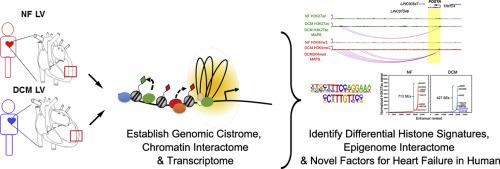Journal of Molecular and Cellular Cardiology ( IF 4.9 ) Pub Date : 2020-06-10 , DOI: 10.1016/j.yjmcc.2020.06.001 Chia-Feng Liu 1 , Armen Abnousi 2 , Peter Bazeley 2 , Ying Ni 3 , Michael Morley 4 , Christine S Moravec 1 , Ming Hu 2 , W H Wilson Tang 5

|
Background
Acetylation and methylation of histones alter the chromatin structure and accessibility that affect transcriptional regulators binding to enhancers and promoters. The binding of transcriptional regulators enables the interaction between enhancers and promoters, thus affecting gene expression. However, our knowledge of these epigenetic alternations in patients with heart failure remains limited.
Methods and results
From the comprehensive analysis of major histone modifications, 3-dimensional chromatin interactions, and transcriptome in left ventricular (LV) tissues from dilated cardiomyopathy (DCM) patients and non-heart failure (NF) donors, differential active enhancer and promoter regions were identified between NF and DCM. Moreover, the genome-wide average promoter signal is significantly lower in DCM than in NF. Super-enhancer (SE) analysis revealed that fewer SEs were found in DCM LVs than in NF ones, and three unique SE-associated genes between NF and DCM were identified. Moreover, SEs are enriched within the genomic region associated with long-range chromatin interactions. The differential enhancer-promoter interactions were observed in the known heart failure gene loci and are correlated with the gene expression levels. Motif analysis identified known cardiac factors and possible novel players for DCM.
Conclusions
We have established the cistrome of four histone modifications and chromatin interactome for enhancers and promoters in NF and DCM tissues. Differential histone modifications and enhancer-promoter interactions were found in DCM, which were associated with gene expression levels of a subset of disease-associated genes in human heart failure.
中文翻译:

对组蛋白修饰和长程染色质相互作用的全局分析揭示了人类扩张型心肌病中的差异化基因组变化和新的转录参与者。
背景
组蛋白的乙酰化和甲基化会改变染色质结构和可及性,从而影响转录调节因子与增强子和启动子的结合。转录调节因子的结合使增强子和启动子之间发生相互作用,从而影响基因表达。然而,我们对心力衰竭患者的这些表观遗传改变的了解仍然有限。
方法和结果
通过对扩张型心肌病 (DCM) 患者和非心力衰竭 (NF) 供体的左心室 (LV) 组织中主要组蛋白修饰、3 维染色质相互作用和转录组的综合分析,确定了不同的活性增强子和启动子区域NF 和 DCM。此外,DCM 中的全基因组平均启动子信号明显低于 NF。超级增强子 (SE) 分析显示,在 DCM LV 中发现的 SE 比在 NF 中发现的 SE 少,并且鉴定了 NF 和 DCM 之间的三个独特的 SE 相关基因。此外,SE 在与长程染色质相互作用相关的基因组区域内富集。在已知的心力衰竭基因位点中观察到不同的增强子-启动子相互作用,并且与基因表达水平相关。
结论
我们已经为 NF 和 DCM 组织中的增强子和启动子建立了四种组蛋白修饰和染色质相互作用组的 cistrome。在 DCM 中发现了差异组蛋白修饰和增强子-启动子相互作用,这与人类心力衰竭中疾病相关基因子集的基因表达水平相关。











































 京公网安备 11010802027423号
京公网安备 11010802027423号